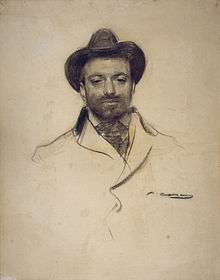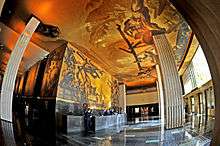Josep Maria Sert

Josep Maria Sert i Badia (Catalan pronunciation: [ʒuˈzɛb məˈɾi.ə ˈsɛrt]) (Barcelona, 21 December 1874 – 27 November 1945, buried in the Vic cathedral) was a Spanish muralist, the son of an affluent textile industry family and friend of Salvador Dalí.[1] He was particularly known for his grisaille style, often in gold and black.
Complementing his knowledge in Paris
Beginning on his trip to Paris in 1899, aged 25, he first became involved on a personal and private level with artists ascribed to the group known as Les Nabis, gravitating around Paul Ranson (1864–1909), who had studied at the renowned private Académie Julian, founded in 1868 by painter Rodolphe Julian. The Académie Julian, along with Académie Colarossi, were frequented by would-be foreign painters, engravers and sculptors, both male and female, including Americans, and, unlike the official École des Beaux Arts, accepted female students and allowed them to draw from the nude male mode. Many of the nude models gracing today millionaires' residences and the world's museums came, either as students or models or both, from such private, none-too-prudish Paris art schools.
Notes on Sert's private life
Sert married the well-known Misia Godebska, a.k.a. Misia Sert, (born Maria Zofia Olga Zenajda Godebska; 30 March 1872 – 1950), a pianist of Polish descent who hosted an artistic salon in Paris. She was a patron and friend of numerous artists, for whom she regularly posed. Her father, Cyprian Godebski (1835–1909), was a renowned Polish sculptor and professor at the Imperial Academy of Arts in St. Petersburg from 1870. Her mother, Zofia Servais, was the daughter of a noted Belgian cellist, Adrien-François Servais.
But after a few years, in 1928, he left her for the sculptress Isabelle Roussadana Mdivani (1906–1938), a.k.a. Roussie, sister of the famous Serge, Alexis, David, and Nina, the 5 siblings from a Georgian-Russian Nobility family emigrated after the Russian Revolution in 1917, known in Paris as the "Marrying Mdivani", because of the notorious marriages they achieved with moneyed and prestigious people from Europe and America.
Locations of Sert's works
Best-known public murals are in the Hôtel de Ville in Paris, the Cathedral of Vic in Barcelona, the League of Nations in Geneva and, in New York City, at the Waldorf-Astoria and 30 Rockefeller Center, the GE Center. There, his “American Progress” replaced Diego Rivera’s mural Man at the Crossroads, which Nelson Rockefeller destroyed because it included an image of Lenin. .
Gallery
-

Apollo flying through the Clouds (1913)
-

Satyr watching some Nymphs dancing (1913)
-

The Elephant Fountain (1913)
-

The Fountains Bridge (1913)
-

The Triumph of Apollo (1913)
-

American Progress
See also
References
External links
- See the murals at the http://www.ireference.ca/search/Rockefeller%20center/ Rockefeller Center in New York City.